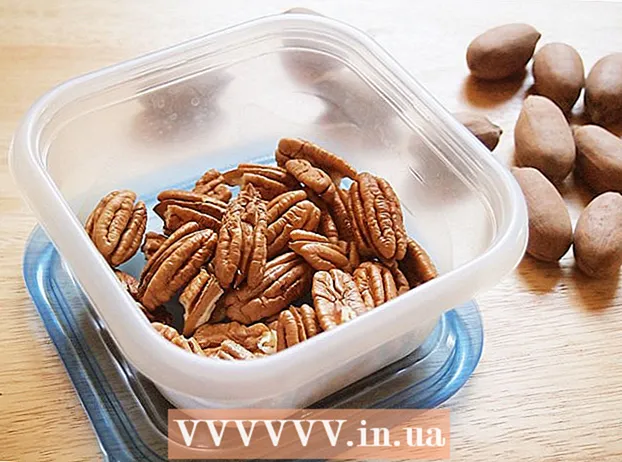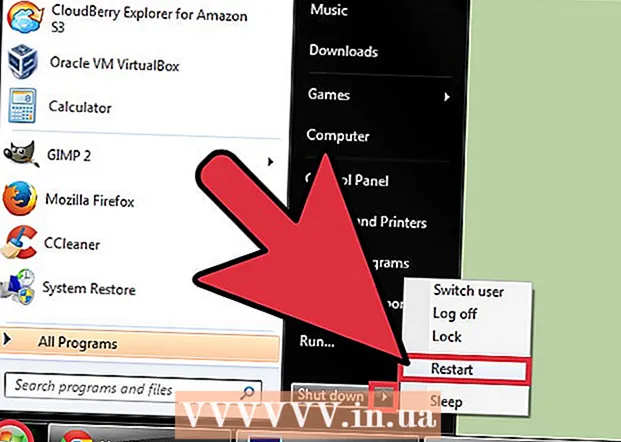
Content
- Steps
- Method 1 of 3: Assessing the Situation
- Method 2 of 3: Feeding your chick
- Method 3 of 3: Caring for a Chick
- Warnings
Chicks that have fallen out of the nest are quite common in spring. Their unhappy squeak awakens the maternal instinct even in the hardest of hearts. It's natural that you want to pick up a chick and go out. But before you do this, you need to spend some time assessing the situation and making sure you are doing the very best for the chick. Was he actually abandoned? Are there centers nearby that could provide better care for him? If you choose to feed your chick on your own, it is important that you understand the responsibilities you are taking on. Chicks are very delicate creatures that need to be fed almost constantly. If you think you're ready for it, this article will tell you everything you need to know about raising and caring for your chick.
Steps
Method 1 of 3: Assessing the Situation
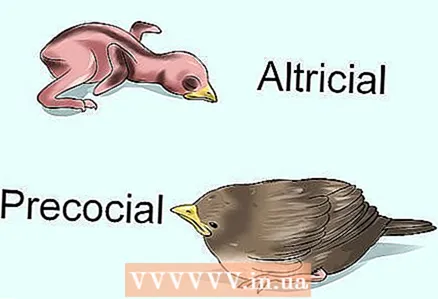 1 Determine if the chick belongs to immature-born or mature-born (brood) birds. Immature birds are those in which chicks hatch blind, without feathers and completely dependent on their parents for food and warmth. Most passerines and songbirds are immature-born, such as robins, jays, cardinals. Breeding birds are more developed at the time of hatching, they are born sighted, have soft fluffy feathers. They are able to walk and immediately begin to follow their mother, collecting food along the way. Examples of such birds are plovers, ducks, geese.
1 Determine if the chick belongs to immature-born or mature-born (brood) birds. Immature birds are those in which chicks hatch blind, without feathers and completely dependent on their parents for food and warmth. Most passerines and songbirds are immature-born, such as robins, jays, cardinals. Breeding birds are more developed at the time of hatching, they are born sighted, have soft fluffy feathers. They are able to walk and immediately begin to follow their mother, collecting food along the way. Examples of such birds are plovers, ducks, geese. - Caring for mature-born birds is much easier, but they are less likely to need help. Brood birds usually build nests on the ground, so chicks cannot fall out of it to the ground. If you find a lost brood bird chick, make an effort to reunite it with its mother before taking it home.
- Newly hatched immature chicks are completely helpless, so they need help. Usually, immature chicks that have fallen from the nest can be found in suburban areas.In some cases it will be possible to return them to the nest, in other cases you will have to take care of them yourself. It is also perfectly acceptable to leave the chick where it is and let nature take its course.
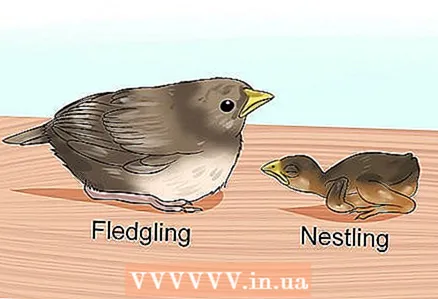 2 Determine if the chick has fledged or not yet. If you find an immature-born bird that you suspect has fallen out of the nest or has been abandoned, you must determine if it is fledging or not. Fledglings are too immature to leave the nest, they may have undeveloped feathers and even have their eyes not open. Fledging chicks are older, they have developed feathers and are strong enough to learn to fly. They can leave the nest and know how to sit and hold on to branches.
2 Determine if the chick has fledged or not yet. If you find an immature-born bird that you suspect has fallen out of the nest or has been abandoned, you must determine if it is fledging or not. Fledglings are too immature to leave the nest, they may have undeveloped feathers and even have their eyes not open. Fledging chicks are older, they have developed feathers and are strong enough to learn to fly. They can leave the nest and know how to sit and hold on to branches. - If the chick you find is fledgling, it should not be outside the nest, something is really wrong. He could fall out of the nest or be pushed out of it by stronger chicks. An abandoned fledgling chick has almost no chance of survival if left alone.
- If you encounter a fledgling chick, you can spend some time assessing the situation before taking the hero. While it may seem like the chick has fallen out of its nest or has been thrown when it flutters and chirps helplessly on the ground, it may be just learning to fly. If you watch the chick long enough, you may spot parents regularly flying over to feed it. If this is your case, then you definitely should not interfere.
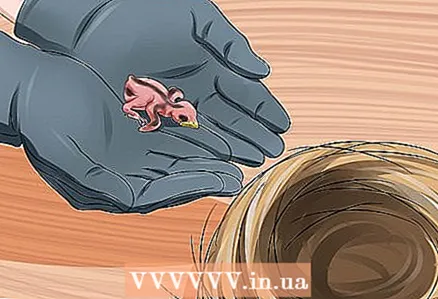 3 If possible, put the chick back in the nest. If you are sure that the chick you met has not yet fledged and is lying helplessly on the ground, there is probably an opportunity to bring it back to the nest. First, see if you can see nests in a nearby tree or bush. It can be well hidden or in a hard-to-reach place. Then grab the chick with one hand from below, covering with the other from above, hold it there until it gets warm. Inspect it for damage, if everything is in order, carefully return it to the socket.
3 If possible, put the chick back in the nest. If you are sure that the chick you met has not yet fledged and is lying helplessly on the ground, there is probably an opportunity to bring it back to the nest. First, see if you can see nests in a nearby tree or bush. It can be well hidden or in a hard-to-reach place. Then grab the chick with one hand from below, covering with the other from above, hold it there until it gets warm. Inspect it for damage, if everything is in order, carefully return it to the socket. - Do not worry about the fact that the parents may abandon the chick because of the smell of the person on it, these are all fairy tales. Birds have a very weak sense of smell, they identify their children mainly by their appearance and voice. In most cases, they take back the fallen chick.
- After the chick returns to the nest, you should not stumble around to check that the parents are back, so you will only scare them away. If you can, observe the nest from the window of the house with binoculars.
- Be aware that in many cases, the return of a chick to the nest does not mean that it will survive. If it is the weakest chick, the chances are high that it will be thrown out again by stronger chicks during the struggle for food and warmth.
- If you notice dead chicks in the nest, then the nest has been abandoned and there is no point in returning the fallen chick there. In such a situation, you will have to take care of the chick, as well as its surviving siblings, if you want to ensure their survival.
 4 Make a substitute nest, if necessary. Sometimes even entire nests can fall due to strong winds, tree pruning or predators. If this is your case, you may be able to save the nest (or make a new one) and place the chicks there. If the original nest still hasn't fallen apart, you can place it in a berry basket or oiler (with holes for drainage) and use some wire to hang the nest from a branch. Try to secure the socket in its original place. If this is not possible, the branch closest to it will do. Just make sure the selected area is covered and not in direct sunlight.
4 Make a substitute nest, if necessary. Sometimes even entire nests can fall due to strong winds, tree pruning or predators. If this is your case, you may be able to save the nest (or make a new one) and place the chicks there. If the original nest still hasn't fallen apart, you can place it in a berry basket or oiler (with holes for drainage) and use some wire to hang the nest from a branch. Try to secure the socket in its original place. If this is not possible, the branch closest to it will do. Just make sure the selected area is covered and not in direct sunlight. - Collect fallen chicks and warm them with your hands before placing them in the nest. Leave the area, but try to keep an eye on the nest from afar.Parents may find it suspicious of another nest instead of the old one, but the instinct of caring for the offspring should help them overcome doubts.
- If the original nest is completely destroyed, you can make a new one by placing paper towels on the bottom of the basket. Even if the original nest was made from grass, you should not line the nest you made with grass, as it contains moisture and can overcool the chicks.
 5 If you are sure that the chicks are abandoned, try to find a rehabilitation center. It is important to establish reliably the fact that the chicks are abandoned before collecting them. The most common situations in which chicks need help are: when you find a fledgling chick but cannot locate or reach the nest; when a fallen chick is injured, weak or dirty; when you watched the replacement nest for more than two hours and the parents did not return to feed the chicks.
5 If you are sure that the chicks are abandoned, try to find a rehabilitation center. It is important to establish reliably the fact that the chicks are abandoned before collecting them. The most common situations in which chicks need help are: when you find a fledgling chick but cannot locate or reach the nest; when a fallen chick is injured, weak or dirty; when you watched the replacement nest for more than two hours and the parents did not return to feed the chicks. - The best thing in this situation is to contact a rehabilitation center, where they can take care of the chicks. These centers can be staffed with experienced chick rearing specialists to give them the best chance of survival.
- If you are unsure of where to look for a rehabilitation center, contact your veterinary clinic or foresters for guidance. In some cases, there may not be a bird or wildlife rehabilitation center, but there may be private centers.
- If none of the above works for you, or if you are unable to transport the bird to rehab, it may be necessary to take care of the chick on your own. Remember this should be the last option, as raising and caring for the chicks is extremely difficult and the chances of survival are low.
- Also, keeping a wild bird in captivity is against moral rules.
Method 2 of 3: Feeding your chick
 1 Feed the chick every 15-20 minutes from sunrise to sunset. Chicks are very demanding on feeding schedules, and their parents make hundreds of food travels every day. To recreate this feeding schedule, you must feed the chick every 15-20 minutes from sunrise to sunset.
1 Feed the chick every 15-20 minutes from sunrise to sunset. Chicks are very demanding on feeding schedules, and their parents make hundreds of food travels every day. To recreate this feeding schedule, you must feed the chick every 15-20 minutes from sunrise to sunset. - When the chick opens its eyes and it has several feathers, you can extend the feeding intervals to 30-45 minutes. Then you can gradually increase the amount of food given per feeding and reduce the number of feedings accordingly.
- When the chick is strong enough to get out of the nest and starts jumping around the box in which it is located, you can feed it about once an hour. Gradually, you can reduce this time to 1 feed every 2-3 hours and start leaving food pieces in the box for the chick to pick up on its own.
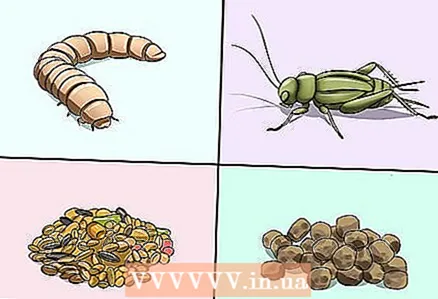 2 Know what to feed your chick. There are various food options for the chick to consume, however, most experts say that as long as the chick is getting the nutrients it needs, what kind of food it is fed is not critical. Even though different species of adult birds have different diets, most chicks have very similar requirements, they need food rich in protein.
2 Know what to feed your chick. There are various food options for the chick to consume, however, most experts say that as long as the chick is getting the nutrients it needs, what kind of food it is fed is not critical. Even though different species of adult birds have different diets, most chicks have very similar requirements, they need food rich in protein. - The ideal starter diet for a newly hatched chick consists of 60% puppy or kitten food, 20% hard-boiled eggs, and an additional 20% mealworms (available for purchase).
- Puppy or kitten food should be soaked until it reaches a spongy consistency, but should not drip as the chick may choke on excess water. Boiled eggs and mealworms should be finely chopped so that the chick can swallow them.
 3 Start changing your diet as your chick grows up. As the chick starts to grow up and bounce around the box, you can start changing its diet to match what it should eat as an adult.
3 Start changing your diet as your chick grows up. As the chick starts to grow up and bounce around the box, you can start changing its diet to match what it should eat as an adult. - Insectivorous birds will eat earthworms, grasshoppers and crickets, which must be cut into small pieces together with whatever insects you can find in the insect trap.
- Birds that prefer to eat fruit will eat berries, grapes, and raisins soaked in water.
 4 Know which bird species require a specific diet. Exceptions to the above diet include pigeons, parrots, hummingbirds, fish-eating birds, birds of prey, and any chicks of mature-born birds.
4 Know which bird species require a specific diet. Exceptions to the above diet include pigeons, parrots, hummingbirds, fish-eating birds, birds of prey, and any chicks of mature-born birds. - Pigeons and parrots usually eat so-called “bird's milk,” a substance that the mother regurgitates. To recreate it, you will have to feed these chicks with a composition for feeding parrots (you can buy it at a pet store) from a syringe without a needle.
- Despite the fact that it is unlikely that you will meet other species of birds, their needs are as follows: hummingbirds need a special nectar diet, birds that eat fish need small-cut small fish (you can buy it in a fish store), birds of prey need insects, rodents and small chicks, and mature-born chicks will thrive on a turkey diet.
 5 Do not feed chicks with bread or milk. Many people make the mistake of feeding their chicks with bread or milk. Unlike mammals, milk is not part of the diet of birds, they will not be able to feed on it. And bread is full of empty calories and won't provide the chick with the nutrients it needs to survive. You should also ensure that the food you feed to the chick is at room temperature.
5 Do not feed chicks with bread or milk. Many people make the mistake of feeding their chicks with bread or milk. Unlike mammals, milk is not part of the diet of birds, they will not be able to feed on it. And bread is full of empty calories and won't provide the chick with the nutrients it needs to survive. You should also ensure that the food you feed to the chick is at room temperature.  6 Use the correct feeding technique. Feeding chicks should be very careful. The best tool is blunt tweezers or a plastic clip. If you don't have either one, fine Chinese sticks (thin enough for the chick's mouth) will do. To feed the chick, take some food with a pair of tweezers, a clip, or Chinese chopsticks and dip it into the chick's mouth.
6 Use the correct feeding technique. Feeding chicks should be very careful. The best tool is blunt tweezers or a plastic clip. If you don't have either one, fine Chinese sticks (thin enough for the chick's mouth) will do. To feed the chick, take some food with a pair of tweezers, a clip, or Chinese chopsticks and dip it into the chick's mouth. - Do not be afraid that the chick will choke, the glottis in birds closes automatically during feeding.
- If the chick does not open its beak, tap it slightly with your feeding tool or rub the edge of the beak with food. This will be a signal to him that it is time for feeding. If the chick still does not open its beak, do it carefully yourself.
- Continue feeding the chick until it stops opening its beak or begins to refuse food. It is important not to overfeed the chick.
 7 Avoid giving the chick water. Chicks usually do not consume water, as water can enter the lungs and suffocate them. They can only be given water when they are old enough and start jumping on the box. At this stage, you can place a shallow container of water (such as a can lid) in the box for the chick to drink on its own.
7 Avoid giving the chick water. Chicks usually do not consume water, as water can enter the lungs and suffocate them. They can only be given water when they are old enough and start jumping on the box. At this stage, you can place a shallow container of water (such as a can lid) in the box for the chick to drink on its own. - You can place a rock or a couple of marble pieces in a container of water to keep the bird from sitting in the water.
- If you think the chick is dehydrated, you will need to bring it to your veterinarian who can provide the necessary fluid injections.
Method 3 of 3: Caring for a Chick
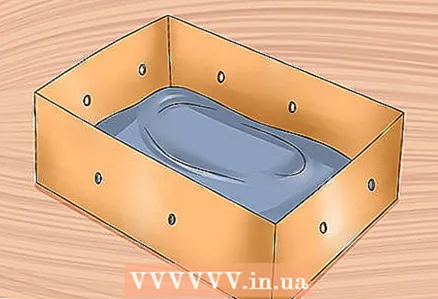 1 Make a temporary nest for the chick. The best way to make a replacement nest is to use a cardboard box, such as a shoe, in which you will have to make a number of holes. Place a small plastic or wooden bowl in the box and line it with unpainted paper towels. This will be a great cozy nest for a chick.
1 Make a temporary nest for the chick. The best way to make a replacement nest is to use a cardboard box, such as a shoe, in which you will have to make a number of holes. Place a small plastic or wooden bowl in the box and line it with unpainted paper towels. This will be a great cozy nest for a chick. - Never line the nest with fibrous or shredded bedding, as it can wrap around the legs and wings or get into the chick's throat. You should also avoid using grass, leaves, moss, as they can be soggy and mold easily.
- You should change the litter in the nest as soon as it becomes damp or dirty.
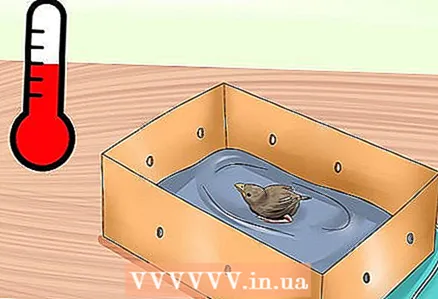 2 Keep the chick warm. If the chick is damp or cold, you should warm it up as soon as you place it in the box. This can be done in a variety of ways.If you have a heating pad, you can set it to a low temperature and place the box on top of it. Alternatively, you can use a zip-lock bag by pouring warm water into it and placing it in a box; or hang a 40-watt lamp over the box.
2 Keep the chick warm. If the chick is damp or cold, you should warm it up as soon as you place it in the box. This can be done in a variety of ways.If you have a heating pad, you can set it to a low temperature and place the box on top of it. Alternatively, you can use a zip-lock bag by pouring warm water into it and placing it in a box; or hang a 40-watt lamp over the box. - It is very important to maintain a constant temperature in the nest, so it is best to place a thermometer in the box. If the chick is less than a week old (he is blind, without feathers), the temperature should be about 35 degrees. It can be lowered by 3 degrees every week.
- It is important to keep the box of chicks out of direct sunlight and drafts. Small chicks are very susceptible to hypothermia and overheating, since they have a sufficiently large body surface in relation to their weight, and they have not yet developed thermal insulation of feathers.
 3 Create a stress-free environment for the chick. Chicks cannot survive if they are not kept in a calm, stress-free environment. Under stress, chicks have a significantly increased heart rate, which is dangerous for their health. As a result, it is necessary to keep the box quiet, out of reach of children and pets. You should also avoid exposing the chick to the following:
3 Create a stress-free environment for the chick. Chicks cannot survive if they are not kept in a calm, stress-free environment. Under stress, chicks have a significantly increased heart rate, which is dangerous for their health. As a result, it is necessary to keep the box quiet, out of reach of children and pets. You should also avoid exposing the chick to the following: - Excessive or inappropriate handling, loud noises, abnormal temperatures, overcrowding (if you have more than one chick), inadequate feeding or nutritional problems.
- You should try to keep the bird at eye level to observe it, as birds do not like being looked down from above. Content at eye level makes you look less like a predator to them.
 4 Maintain a chick's growth chart. You can monitor the chick's growth by weighing it daily to make sure it is gaining weight. You can use a notebook for this. The weight should increase daily, and in 4-6 days it should be twice the weight at hatching. Rapid weight gain should continue during the first two weeks of the chick's life.
4 Maintain a chick's growth chart. You can monitor the chick's growth by weighing it daily to make sure it is gaining weight. You can use a notebook for this. The weight should increase daily, and in 4-6 days it should be twice the weight at hatching. Rapid weight gain should continue during the first two weeks of the chick's life. - In order to check if a chick is growing at the same height as the birds of its species, you will need to check the growth chart for its species of bird.
- If the bird is gaining weight very slowly or not gaining weight at all, this is a clear sign that something is wrong. In such a situation, you must immediately take the bird to a veterinarian or a rehabilitation center, otherwise it is likely to die.
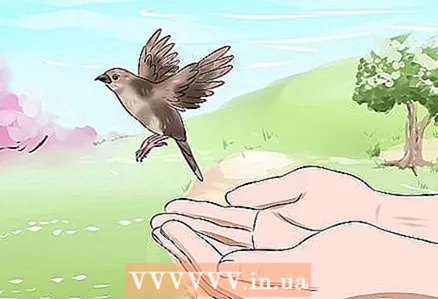 5 Let the bird learn to fly and then release it. When your chick is fully fledged, you will need to transfer it to a large cage or enclosure where it can spread its wings and learn to fly. Don't worry that he doesn't know how to do this. The ability of birds to fly is instinctive. After several unsuccessful attempts, the chick will understand what's what. The training can take 5-15 days.
5 Let the bird learn to fly and then release it. When your chick is fully fledged, you will need to transfer it to a large cage or enclosure where it can spread its wings and learn to fly. Don't worry that he doesn't know how to do this. The ability of birds to fly is instinctive. After several unsuccessful attempts, the chick will understand what's what. The training can take 5-15 days. - Once the chick can easily fly and gain altitude, it is ready to be released. To release a chick, take it to an area where you can see birds of its own kind and where there will be many sources of food.
- If you release a bird in your garden, you can leave the bird's cage there with the door open. Then she will decide for herself whether she is ready to leave.
- The less the bird is kept in captivity, the higher the chance of survival in the wild, so do not delay the release date any longer than necessary.
Warnings
- Birds may pinch or peck at you. Be careful as these are wild animals.

